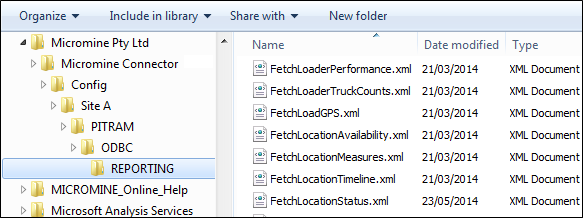Create a FETCH command
To build a report the first thing to do is check if a FETCH command already exists that returns the required data. If one exists, you are ready to Create a Pitram Report. If not, you can create a new FETCH command. The easiest way to do this is to modify an existing one.
- First, create an SQL query that returns the data you require for the report.
- Secondly, make a copy of an existing FETCH command file and rename the file. FETCH commands are located in the following folder:
- Open the copied and renamed file and make the following edits:
- Save your changes to the FETCH Command file in the same folder:
C:\Program Files\Micromine PtyLtd\Micromine DOMEConnector\Config\<sitename>\Pitram\ODBC\REPORTING

In the <m_commandName> tags, type the name of the new FETCH command. The command name must match the name of the file.
Inside the <m_queryTemplate> tags and inside the <![CDATA[ and ]]> opening and closing tags, replace the existing SQL query with your new query:
<?xml version="1.0" encoding="utf-8"?>
<PITRAMCommandDefinitionxmlns:xsd="http://www.w3.org/2001/XMLSchema"xmlns:xsi="http://www.w3.org/2001/XMLSchema-instance">
<m_commandName>FetchTestReport</m_commandName>
<m_queryTemplate>
<!
-- INSERT YOUR QUERY HERE
]]>
</m_queryTemplate>
</PITRAMCommandDefinition>
To edit FETCH commands and queries, use a good text editor such as Notepad++.
When an SQL statement is wrapped automatically, the SQL statement may not compile correctly. Also, some SQL implementations may not permit a statement or clause to be split over more than one line.
Refer to the SQL Examples chapter for more information.
C:\Program Files\Micromine PtyLtd\Micromine DOMEConnector\Config\<sitename>\Pitram\ODBC\REPORTING